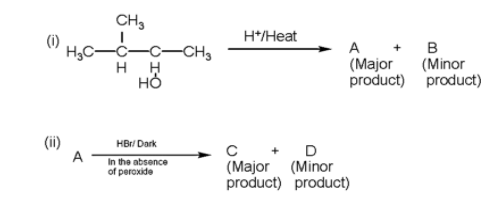Answer
405.3k+ views
Hint: The stability of the carbocation is important in predicting the stability of the molecule. The stability order of the carbocation is tertiary carbocation ˃ secondary carbocation ˃ primary carbocation.
Complete Step-by-Step Answer:
- In the given question, two reactions are given in which we have to find the major product of the reaction.
- Firstly, we will write the first reaction in which firstly the hydroxyl ion will be released due to bond breakage due to heat and a secondary carbocation will be formed.

- Now, as we know, secondary carbocation is less stable than the tertiary carbocation because more alkyl groups are attached with the tertiary carbocation which tends to increase the electron density at the carbocation.
- Now, we will rearrange the position of carbocation by the method of 1,2 hydride shift in which the position of hydrogen atom changes as shown below:

- Now, after the formation of the tertiary carbocation, the hydrogen atom will be released from the adjacent carbon due to which the pi- the bond will be formed.
-And the major product formed is 2-methyl but -2-ene.

-Now, in the second reaction, the compound A is the 2-methyl but -2-ene which undergoes anti- Markovnikov reaction.
-In Anti - Markovnikov reaction, the negatively charged element goes to that carbon atom which has the maximum number of the alkyl group.
-So, here firstly the pi - the bond will break and the addition of the bromine will take place through Anti - Markovnikov rule.

- Here, the bromine attached to the tertiary carbocation is more stable than secondary.
Therefore, the major product A and C are 2-methyl but -2-ene and 2-methyl 2-Bromobutane.
Note: The Anti - markovnikov rule is applicable only in the presence of hydrogen bromide and peroxide. If peroxide is absent in the reaction the negatively charged group attaches through electrophilic addition mechanism.
Complete Step-by-Step Answer:
- In the given question, two reactions are given in which we have to find the major product of the reaction.
- Firstly, we will write the first reaction in which firstly the hydroxyl ion will be released due to bond breakage due to heat and a secondary carbocation will be formed.

- Now, as we know, secondary carbocation is less stable than the tertiary carbocation because more alkyl groups are attached with the tertiary carbocation which tends to increase the electron density at the carbocation.
- Now, we will rearrange the position of carbocation by the method of 1,2 hydride shift in which the position of hydrogen atom changes as shown below:

- Now, after the formation of the tertiary carbocation, the hydrogen atom will be released from the adjacent carbon due to which the pi- the bond will be formed.
-And the major product formed is 2-methyl but -2-ene.

-Now, in the second reaction, the compound A is the 2-methyl but -2-ene which undergoes anti- Markovnikov reaction.
-In Anti - Markovnikov reaction, the negatively charged element goes to that carbon atom which has the maximum number of the alkyl group.
-So, here firstly the pi - the bond will break and the addition of the bromine will take place through Anti - Markovnikov rule.

- Here, the bromine attached to the tertiary carbocation is more stable than secondary.
Therefore, the major product A and C are 2-methyl but -2-ene and 2-methyl 2-Bromobutane.
Note: The Anti - markovnikov rule is applicable only in the presence of hydrogen bromide and peroxide. If peroxide is absent in the reaction the negatively charged group attaches through electrophilic addition mechanism.
Recently Updated Pages
How many sigma and pi bonds are present in HCequiv class 11 chemistry CBSE

Why Are Noble Gases NonReactive class 11 chemistry CBSE

Let X and Y be the sets of all positive divisors of class 11 maths CBSE

Let x and y be 2 real numbers which satisfy the equations class 11 maths CBSE

Let x 4log 2sqrt 9k 1 + 7 and y dfrac132log 2sqrt5 class 11 maths CBSE

Let x22ax+b20 and x22bx+a20 be two equations Then the class 11 maths CBSE

Trending doubts
Fill the blanks with the suitable prepositions 1 The class 9 english CBSE

At which age domestication of animals started A Neolithic class 11 social science CBSE

Which are the Top 10 Largest Countries of the World?

Give 10 examples for herbs , shrubs , climbers , creepers

Difference between Prokaryotic cell and Eukaryotic class 11 biology CBSE

Difference Between Plant Cell and Animal Cell

Write a letter to the principal requesting him to grant class 10 english CBSE

Change the following sentences into negative and interrogative class 10 english CBSE

Fill in the blanks A 1 lakh ten thousand B 1 million class 9 maths CBSE




